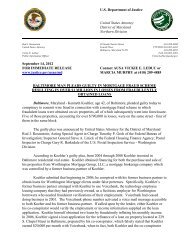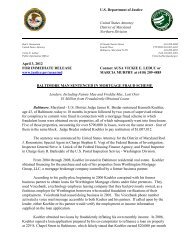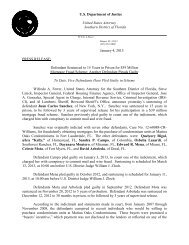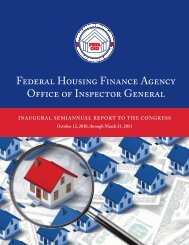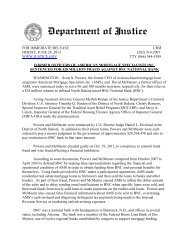FEDERAL
Sixth Semiannual Report to the Congress - Federal Housing ...
Sixth Semiannual Report to the Congress - Federal Housing ...
- No tags were found...
You also want an ePaper? Increase the reach of your titles
YUMPU automatically turns print PDFs into web optimized ePapers that Google loves.
usiness segment driven by stronger credit quality,<br />
(2) increases in guarantee fee income as a result of<br />
FHFA direction, (3) an increase in home prices<br />
causing a reduction in defaults, and (4) derivative<br />
gains due to an increase in swap rates.<br />
Continued Improvement in Credit Quality<br />
of New Single-Family Business<br />
Fannie Mae’s credit-related income for the six<br />
months ended June 30, 2013, was $6.9 billion,<br />
compared with $772 million for the same period in<br />
2012. 23 Freddie Mac’s credit-related income for the<br />
six months ended June 30, 2013, was $1.2 billion,<br />
compared with credit-related expenses of $2.1 billion<br />
for the same period in 2012. 24 The increase in creditrelated<br />
income is primarily the result of continued<br />
improvements in the credit quality of each enterprise’s<br />
single-family book of business—as higher credit<br />
quality leads to fewer loan delinquencies—and the<br />
increase in national home prices. 25<br />
The enterprises’ single-family books of business consist<br />
of loans purchased and guaranteed that generate<br />
interest and guarantee fee income. The credit quality<br />
of the single-family loans acquired by the enterprises<br />
beginning in 2009 (excluding HARP and other<br />
relief refinance mortgages) is significantly better than<br />
that of those loans acquired from 2005 to 2008, as<br />
measured by loan-to-value (LTV) ratios, FICO scores,<br />
and the proportion of loans underwritten with fully<br />
documented income. 26<br />
This improved credit quality is attributed to:<br />
(1) more stringent credit policies and underwriting<br />
standards, (2) tighter mortgage insurers’ and lenders’<br />
underwriting practices, and (3) fewer purchases of<br />
loans with higher-risk attributes (e.g., Alt-A, interestonly,<br />
credit scores below 620, and LTV ratios above<br />
90%). 27<br />
Further, the enterprises are now holding more loans<br />
with higher credit quality acquired from 2009 to<br />
present in their single-family books of business. As of<br />
June 30, 2013, loans acquired after 2008 comprised<br />
72% and 70%, respectively, of Fannie Mae’s and<br />
Freddie Mac’s books of business. 28 Conversely, the<br />
legacy housing boom loans acquired from 2005<br />
through 2008, which have a higher probability of<br />
credit defects, have declined to 17% of the singlefamily<br />
book of business for Fannie Mae and 19% for<br />
Freddie Mac as of June 30, 2013, compared with 26%<br />
and 28%, respectively, as of June 30, 2012. 29<br />
Increase in Guarantee Fee Prices<br />
A significant source of income for the enterprises<br />
comes from receiving guarantee fees. 30 MBS investors<br />
of both single-family and multifamily loans pay these<br />
fees to gain an enterprise guarantee of the principal<br />
and interest payment. 31 In 2012, FHFA directed<br />
the enterprises to increase their guarantee fees, and<br />
FHFA intends to direct further gradual guarantee<br />
fee increases to achieve several objectives, such as<br />
increasing private-sector investment in mortgage<br />
credit risk. 32 As a result, guarantee fee income<br />
increased for the six months ended June 30, 2013,<br />
with an expectation that future increases will further<br />
augment revenue. Additionally, Fannie Mae’s increase<br />
for the six months ended June 30, 2013, is a result<br />
of liquidating loans with lower guarantee fees while<br />
adding loans with higher guarantee fees to their<br />
multifamily book of business. 33<br />
Fannie Mae’s combined single-family and multifamily<br />
guarantee fee income for the six months ended<br />
June 30, 2013, was $5.5 billion, compared with<br />
$4.4 billion for the same period in 2012—a 26%<br />
increase; Freddie Mac’s combined single-family and<br />
multifamily guarantee fee income for the six months<br />
ended June 30, 2013, was $2.6 billion, compared<br />
with $2.1 billion for the same period in 2012—a 25%<br />
increase. 34<br />
42 Federal Housing Finance Agency Office of Inspector General



